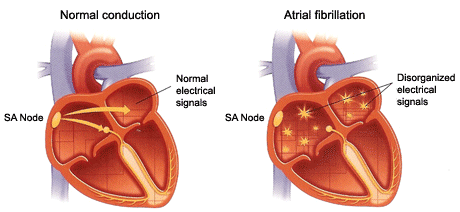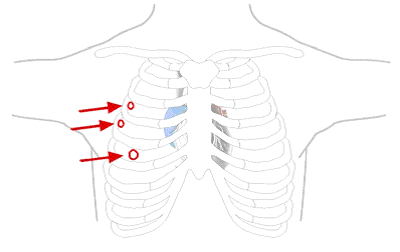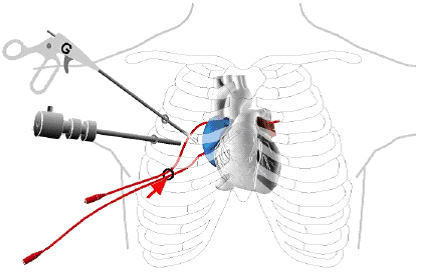Mini-Maze Procedure
The Mini-Maze is performed to treat atrial fibrillation (AFib), a type of abnormal heart rhythm (arrhythmia). The term "arrhythmia" refers to any change from the normal sequence of electrical impulses. Normally, the heart beat begins when an electrical impulse from the sinus node or your heart’s “natural pacemaker” moves through it. As the signal spreads from the top of the heart to the bottom, it coordinates the timing of heart cell activity. For the heart to beat properly, the signal must travel down a specific path to reach the ventricles. When the heart’s natural pacemaker is defective, the heart beat may be too early (premature), too slow (bradycardia), too fast (tachycardia), or too erratic (fibrillation).
During AFib, the heartbeat is often erratic and fast (Figure 1). Episodes of atrial fibrillation can come and go, or you may develop AFib that doesn’t go away. Though AFib itself usually isn’t life-threatening, it is a serious medical condition that may lead to a stroke.
 |
| Figure 1 |
The Mini-Maze is a minimally-invasive procedure that uses ablation energy to scar the specific heart area that triggers the AFib. This procedure is the preferred method of AFib treatment. However, for those individuals that require a simultaneous open-heart surgery, such as CABG or aortic valve repair or replacement or mitral valve repair or replacement, a Maze procedure (type of open-heart surgery) is preferred.
Do you have a question? Request more information or an appointment and we will connect you with an RWJBarnabas Health cardiovascular expert.
How to Prepare for the Procedure
Before the procedure, your doctor and treatment team will explain to you what to expect before, during and after the procedure and potential risks of the procedure. Talk to your doctor about:
- All medications, herbal products and dietary supplements you are currently taking and ask for their recommendations about each.
- Diabetes and how to adjust your medicine on the day of the procedure.
- Radiation exposure, especially for those that are pregnant.
- Any allergies to medicines, latex, tape, iodine, and anesthetic agents.
- Any history of bleeding disorders.
- Any implanted device (for example, a pacemaker or an ICD).
- Any body piercings on your chest or abdomen.
Other recommendations include:
- Eat a normal meal the evening before the procedure. However, do not eat, drink or chew anything after midnight before your procedure. If you must take medications, only take them with sips of water.
- Leave all jewelry at home.
- Remove all makeup and nail polish.
- Wear comfortable clothing when you come to the hospital.
- If you normally wear dentures, glasses, or hearing devices at home, plan to wear them during the procedure.
What to Expect Before the Procedure
Before the procedure, your doctor may perform a variety of diagnostic tests, including:
What to Expect During the Procedure
A Mini-Maze procedure usually takes 2 to 3 hours, but the preparation and recovery time may add several hours. This procedure is usually performed in the cardiac catheterization laboratory. Check with your doctor about the details of the procedure. In general:
- You will change into a hospital gown.
- A nurse will start the intravenous (IV) line in your arm which will administer medications and fluids during the procedure.
- Prior to starting the procedure, you will also receive regional anesthesia (to numb specific area). Once the local anesthetic has taken effect, your doctor will make three to six small keyhole incisions on each side your chest, under the ribs (Figure 2).
- Through these keyholes, your doctor will insert the ablation device (Figure 3).
- The ablation device then proceeds to deliver hot or cold energy to the atrial tissue. This energy destroys (ablates) parts of the atria in a “maze-like” sequence, which in turn creates a new pattern for electrical pathways. The scar tissue that forms after the ablation prevents the abnormal electrical impulses from affecting the rest of the heart.
- After the ablation, all equipment is removed out of your body and the insertion site is closed with a closure device (collagen) or sutures.
 |
| Figure 2 |
 |
| Figure 3 |
What to Expect After the Procedure
After the procedure, you may be taken to a recovery room or the intensive care unit (ICU) for several days. This procedure usually requires a hospital stay of 3 to 4 days, or even longer. Other recommendations include:
General Guidelines
- A nurse will monitor your vital signs, the insertion site, and circulation and sensation in the affected leg or arm.
- Most patients must remain in bed for several hours afterwards.
- Tell your nurse right away if you feel any chest pain or tightness, or any other pain, as well as any feelings of warmth, bleeding, or pain at the insertion site.
- You'll be given oxygen, fluids, nutrition and medications through intravenous (IV) lines.
- After the specified period of bed rest has been completed, you may get out of bed with the help of your nurse.
- Your doctor will give you instructions to follow during your recovery.
Once home, follow general health guidelines, including eating a heart-healthy diet. If there are no complications from surgery, you should be able to return to work in two to three weeks.
After surgery, you may still experience some symptoms of arrhythmia, such as heart palpitations or a lack of energy. This is because it takes up to 6 months for scar tissue to completely form after ablation.
The patient will return to the clinic for follow-up 2, 6 and 12 weeks after surgery. At 6 months, your medical team will evaluate whether normal heart rhythm has been restored.
Traditionally, the surgical treatment for Afib involves a major operation and recovery time is extensive. But with the mini-maze minimally invasive surgery, outcomes are as effective as traditional surgery with fewer complication risks than those associated with open heart surgery.
Do you have a question? Request more information and we will connect you with an RWJBarnabas Health cardiovascular expert.
